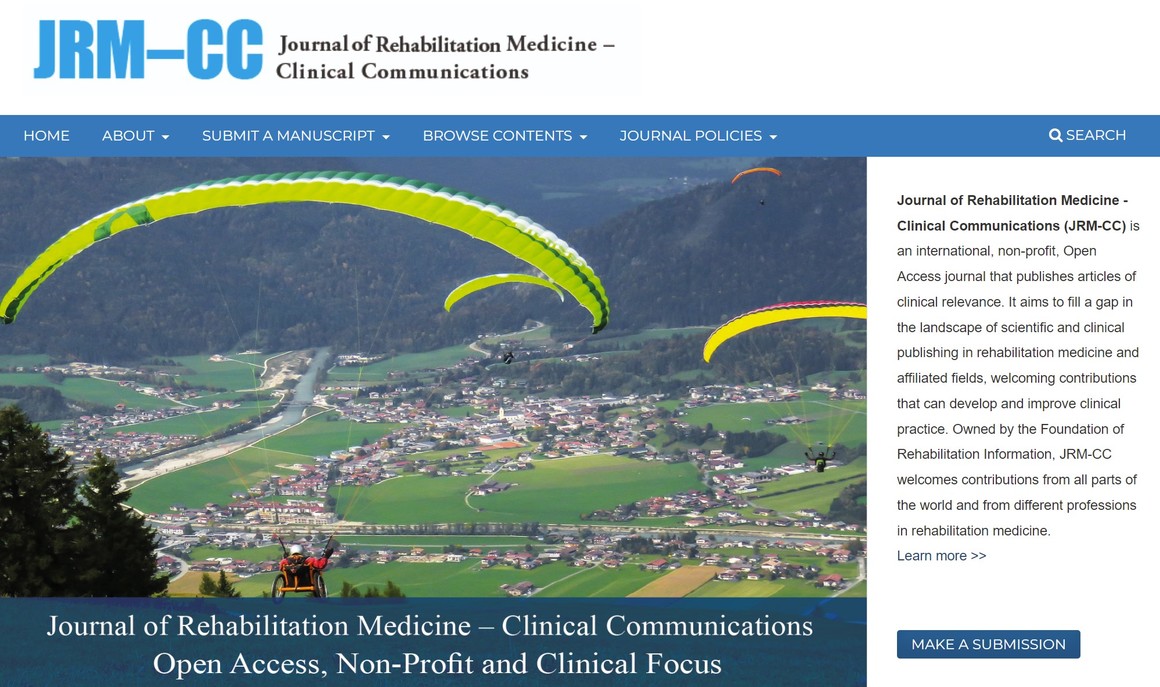Welcome to the February JRM/JRM-CC Newsletter | | From the contents this month:
- The Editors’ Choice of the month for JRM, accompanied by a short commentary by the authors
- Additional highlighted articles
- Most read articles in February
- Most cited articles 2019 - 2021
- The announcement of the newly launched publication system and website for JRM-CC
Please get in touch with us with any feedback on either the journals or the new newsletter format. We want to make sure we maximize the value for you.
Yours sincerely,
Therese Granlund
Editorial Manager for Journal of Rehabilitation Medicine
Managing Director, Medical Journals Sweden AB
S:t Johannesgatan 22
753 12 Uppsala, Sweden | | | | Launch of new website for JRM-CC | | We are excited to announce that Journal of Rehabilitation Medicine - Clinical Communications (JRM-CC) has now followed Journal of Rehabilitation Medicine (JRM) and has just transitioned publication system to a system called Open Journal Systems (OJS).The new publication platform affords the two journals the opportunity to improve the quality and speed of our publication process as well as to expand the reach of its published contents. |  | | Advantages that this change in system can offer JRM and JRM-CC and its stakeholders include:
• Modernization and conformation to industry standards – OJS was designed specifically for open access, peer-reviewed publishing and supports for example JATS XML standardization, which has become the standard ‘model’ for journal articles. JATS XML is used in most scholarly communities today (including public archives like PubMed Central amongst other indexes and hosts).
• Increased reach of journal contents – by offering a platform that is optimized for content discovery across search engines such as Google, Google Scholar, and Bing, and that provides comprehensive indexing. In short, contents on the new platform will be machine-readable and searchable meaning they can more easily be accessed, read and indexed.
• Increased efficiency and transparency in the publication process - saving time and energy for both authors and the editorial team while maintaining integrity throughout the editorial process. By getting an end-to-end journal publishing and management system, all steps of the publication can be handled in the same system and a lot of what used to be manual work will now be automated. Hence the new system not only provides the technical infrastructure for the presentation of contents, but also the complete editorial-management workflow (including submission, peer-review, and indexing).
• Increased quality and security – by streamlining the record-keeping process, JRM and JRM-CC can now offer an even more secure environment for archiving and stewardship of scholarly content.
• Continuous development – with more than 10,000 journals worldwide OJS is continuously being developed with new features being added as scholarly communication is developed.
• Improved user experience – many JRM authors already have an account with OJS and are familiar with the submission process. | | | | | | Subscribe to our mailing list | If you have not already subscribed to the mailing list, click on the link below to subscribe in order to receive these newsletters directly to your inbox. | | | |
|
|
| Editors' Choice
JRM | |  | |
|
|
Author comments
The Functional Independence Measure (FIM™) is an established measure for the assessment of patients and outcome quality. In Switzerland, FIM™ is used for quality monitoring in musculoskeletal and neurological rehabilitation. However, for spinal cord injury (SCI), the Spinal Cord Independence Measure (SCIM) is used. This study examined whether FIM™ and SCIM scores can be equated. Content overlap was assessed and discussed through the ICF (International Classification for Functioning, Disability and Health). The two metrics were equated using statistical true-score equating. The SCIM showed a more comprehensive operational range and enables collecting more clinically meaningful data in SCI specialized centers. | | | | Further Highlighted Articles | | | | | | |
|
|
| Most Read in February | | | | | | | | Most Cited Articles per Year Published 2019-2021 | | 2019
Factors associated with persistent post-concussion symptoms following mild traumatic brain injury in adults
Jennifer Ponsford, Sylvia Nguyen, Marina Downing, Marije Bosch, Joanne E. McKenzie, Simon Turner, Marisa Chau, Duncan Mortimer, Russell L. Gruen, Jonathan Knott, Sally Green
37 citations |
| 2020
Long-term clinical outcomes in survivors of severe acute respiratory syndrome (SARS) and Middle East respiratory syndrome coronavirus (MERS) outbreaks after hospitalisation or ICU admission: A systematic review and meta-analysis
Hassaan Ahmed, Kajal Patel, Darren C. Greenwood, Stephen Halpin, Penny Lewthwaite, Abayomi Salawu, Lorna Eyre, Andrew Breen, Rory O’Connor, Anthony Jones, Manoj Sivan
183 citations |
| |
|
|
|